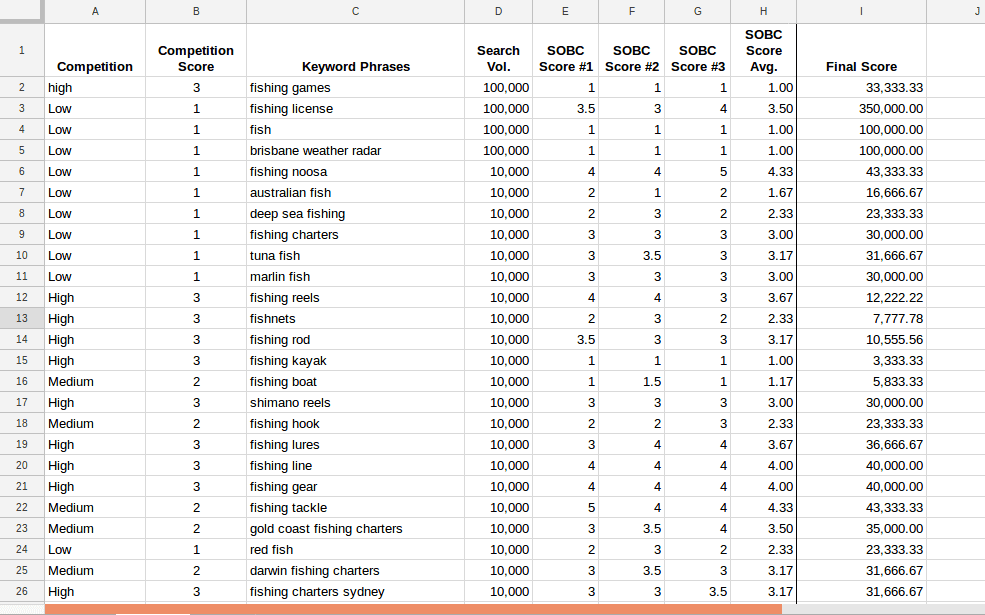
State Of Buy Cycle Score (SOBC)
Keyword List Preparation
Why is it that some keywords work better, or convert better than others? Well, it depends on three things really.
Firstly, whether the keywords you have used are the correct ones or not. Secondly, the level of competition also using those same keywords, or better ones. Thirdly, at what stage is the user ready to buy or convert.
In this blog, we’ll look at the latter to help you understand more about how it impacts on the keywords you choose before optimising your site, or social media platforms, and creating content.
Ok, so the Categories below, group keywords by how close a user is to a point of conversion or buying a product. While different experts in the industry will implement this in slightly varying ways, the principles remain the same.
Each category has a ‘Score’. The score indicates how close a user is to the point of conversion. I refer to this score is as the ‘State Of Buy Cycle Score (or simply referred to as the SOBC).
Using these categories, while keyword brainstorming, it will help you develop a more defined list that will ultimately be more effective.
So, let’s have a look at them.
Branded Keywords
Customers searching with a branded keyword phrase, has already done their research, already knows your brand, and are basically ready to spend money. That equates to good conversion.
You’re unlikely to have many branded keywords in your list, and these keywords will not equate to many impressions on the search engine results. However, what they will do, is provide you with improved click-through rates (CTRs) & conversion stats.
For example:
- SEO & Digital (brand name)
- SEO & Digital Consulting Services (brand name)
- SEO & Digital Marketing
- SEO Consulting Services (brand name)
- Digital Marketing Consulting Services
Note: All of these are highly competitive and very directly related to the brand identity. However, and especially true for the first two, is that if someone was looking for our business directly, because they already know about our services, etc. and ready to engage, this is what they would likely type into a Google search.
SOBC SCORE: 5
Product Keywords
These keywords talk about your Product or Service offered to people. If someone was to use keywords relating to this topic, then it’s likely they are still doing their research.
However, they are very close to spending money, and may in fact settle for your product or service if noticed in the SERPs.
For example:
- How to increase website traffic
- how to optimise a website for search engines
- benefits of email marketing
SOBC SCORE: 4
Competitor Keywords
People using these types of keyword phrases are also likely to be educated enough about a product or service, but are interested in comparing different brands.
If you are prepared in the right way, your business stands a greater chance of being selected over a competitor who also ranked on the same search engine page as you.
For Example:
- Best SEO companies near me
- Best Digital marketing agencies in [country]
- A Digital Marketing company near me
- Email marketing solutions
SOBC SCORE: 3.5
Substitute Product Keywords
People using these types of Keywords are again, very close to buying and are currently exploring some options. They have a general idea about what they want, but still not 100% sure.
For Example:
- Email Marketing
- Digital marketing
- Online Marketing
- Social Media Marketing
SOBC SCORE: 3
Complimentary Product Keywords
These types of users are looking for something a little extra to what they already have, like an add-on sale, or a service that will help them move forward a little more.
These users are not that close to buying, but they are looking around to see what is on offer. Getting one of these users to your site, could lead to a conversion in the near future.
For Example:
- Pay Per Click Advertising
- Social Media Management
- Link Building
- SEO Audits
SOBC SCORE: 2
General Keywords
General keyword phrases are the most common keywords, not specifically covered in the previous categories. People using these keyword types are not ready to buy, and just starting their research.
With these keyword phrases, you want to differ from your competition as much as possible. They will also help you gain more impressions on the SERPs, if done right. However, your conversion stats WILL be low.
For Example:
- How to improve google rankings
- What is SEO?
- What are backlinks?
- Explain Digital Marketing
SOBC SCORE: 1
Ok, so you’ve done your best to understand all that, and then you ask, “How do I use this scoring system?”
It’s a great question, and I don’t want to fluff about. So let’s get straight to it in step by step form:
1. You will still need to create your keyword list of between 50 and 100 keyword phrases, for a specific need.
If you are not ready with this, or not sure how to do this, then please refer to my blog on ‘Creating a Keyword List to Rank better & Convert more’.
2. It’s ideal if your Keyword list is in a Google Sheet, or excel sheet if you prefer, and occupying column C.
3. Now we’ll label other columns as follows:
- A = Competition
- B = Competition score
- D = Search Volume
- E = SOBC Score #1
- F = SOBC Score #2
- G = SOBC Score #3
- H = SOBC Score Average
- I = Final Score
4. If, like me, you used Google’s Keyword Planner to build your list, then each keyword/phrase will have a competition label of High, Medium or Low. They must be pasted into column A.
5. Now assign the following numbers in Column B:
- High = 3
- Medium = 2
- Low = 1
6. Next, paste your search volume amounts into column D, and make sure you have not changed anything so that the alignment with your keywords is correct.
7. Ok, now it’s important to have three people score each keyword phrase on what they believe is the State at which a user is intending to buy. You can use the SOCB Scores above, as a guide.
8. Of course, column H will now formulate the average of those three SOBC Scores for each keyword/phrase.
9. Then Column I will use the following formula to give you a final score:
- =sum(D3*H3)/B3
The higher the score, the better the keyword phrase is with regards to converting users from Search Engine Queries. Otherwise, the lower the score, the more you can rank for general impressions on the SERPs.
You can set this up any way you feel comfortable, and sort the ‘Final Score’ column if you like.
Yes, there is a little bit of work involved. However, if done right, it will provide your with a very good keyword list for on-page optimisation everywhere, and also for content optimisation.
Here is a screenshot of a keyword list our team prepared for an existing client. This client, as you can well guess by now, is targeting the Fishing industry within a specific region, in Australia.

The last thing to add is, once you understand this process better, you can begin to simplify things further.
Using my experience I had already deleted some unnecessary rows with keyword phrases that will not matter. Additionally, I will also add some long-tail phrases to this list once I am satisfied I have the right foundation.
If you need help creating a proper keyword list because you want to rank well AND create more conversion opportunities, contact us to arrange a chat, and let’s see how we can get you moving in the right direction.
Yes, I need help!
Paul Leonard has been successfully providing SEO and Digital consulting services to a number of international clients over the years.
As a founder of HPL Digital Marketing, we are fortunate to have his expertise made available, to help your business grow in the right ways.
